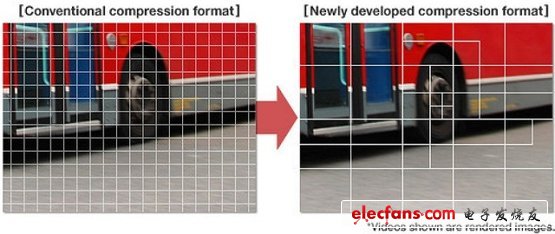In August last year, Ericsson introduced the first H.265 codec, and only six months later, the ITU officially approved the adoption of the HEVC/H.265 standard, which is called high-efficiency video coding. High Efficiency Video Coding) has been considerably improved compared to the current H.264 standard. H.265 is designed to deliver higher quality network video over a limited bandwidth, allowing only the original half of the bandwidth to play the same quality video. This also means that our mobile devices (mobile phones, tablets) will be able to play Full HD (1080P) video directly online. The H.265 standard also supports 4K (4096 & TImes; 2160) and 8K (8192 & TImes; 4320) ultra-high definition video. It can be said that the H.265 standard allows network video to keep up with the "high resolution" of the display screen, possibly In a few months, you can see devices that support H.265 decoding (such as smartphones, graphics cards, etc.). H.264 has ruled the past five years, and in the next five or even ten years, H.265 is likely to become mainstream.
Why H.265 is better than H.264
Before discussing the improvements and benefits of H.265, let's take a look at H.264.
H.264, also known as MPEG-4 AVC (Advanced Video Codec), is a video compression standard and a widely used recording, compression and distribution format for high-precision video. H.264 is known for being a codec standard for Blu-ray Discs, and all Blu-ray players must be able to decode H.264. More importantly, because Apple decided to abandon Adobe's VP6 code and chose H.264, this standard has entered hundreds of millions of iPads and iPhones, becoming the current video coding field. Absolute hegemony, accounting for more than 80% of the share. H.264 is also widely used in network streaming media data, various high definition television terrestrial broadcasts, and satellite television broadcasts.
H.264 has some new features compared to previous coding standards, such as motion compensation for multiple reference frames, variable block size motion compensation, intra prediction coding, etc. By using these new features, H.264 has more coding standards than other coding standards. Higher video quality and lower bitrate have also been recognized.
The coding architecture of H.265/HEVC is similar to the architecture of H.264/AVC, and mainly includes: intra predication (TITI), inter predication (interprediTIon), transform (transform), quantization (quantization), Deblocking filter, entropy coding and other modules. However, in the HEVC coding architecture, the whole is divided into three basic units: coding unit (CU), predictive unit (PU), and transform unit (TU).
Compared to H.264/AVC, H.265/HEVC provides more different tools to reduce the bit rate. In terms of coding units, each macroblock (marcoblock, MB) size in H.264 is fixed 16x16. Pixels, while the H.265 coding unit can be selected from a minimum of 8x8 to a maximum of 64x64. The following figure is an example. The area with a small amount of information (the color change is not obvious, such as the red part of the car body and the gray part of the ground) is larger than the macro block, the coded code word is less, and the details are more ( The macroblocks divided by the tires are correspondingly smaller and more, and the encoded codewords are more, which is equivalent to the important coding of the image, thereby reducing the overall code rate and improving the coding efficiency. At the same time, H.265's intra prediction mode supports 33 directions (H.264 only supports 8), and provides better motion compensation processing and vector prediction methods.

Repeated quality comparison tests have shown that at the same image quality, the video size encoded by H.265 will be reduced by approximately 39-44% compared to H.264. This data will also change accordingly due to the different methods of quality control. The data obtained through subjective visual tests show that the quality of H.265 encoded video can be similar or even better than H.264 encoded video with a 51-74% reduction in code rate, which is essentially better than expected. The signal-to-noise ratio (PSNR) is better. These subjective visual tests cover a wide range of subjects, including psychology and human visual characteristics. Video samples are very broad, although they are not final, but they are also very encouraging results.

Compared with the subjective visual test of H.264 encoded video, we can see that the latter has a much lower code rate than the former.
The current HEVC standard has three modes: Main, Main 10 and Main Still Picture. Main mode supports 8bit color depth (ie, 256 shades of red, green and blue, respectively, a total of 16.7 million colors), and Main 10 mode supports 10bit color depth, which will be used on Ultra HD TV (UHDTV). The first two limit the chroma sampling format to 4:2:0. It is expected to expand the standard in 2014, will support 4:2:2 and 4:4:4 sampling formats (that is, provide higher color reproduction), and multi-view encoding (such as 3D stereo video encoding) .
In fact, the H.265 and H.264 standards have some overlap in various functions. For example, the Hi10P part of the H.264 standard supports video with 10 bit color depth. Another part of H.264 (Hi444PP) can also support 4:4:4 chroma sampling and 14-bit feature depth. In this case, the difference between H.265 and H.264 is that the former can use less bandwidth to provide the same function, at the cost of device computing power: H.265 encoded video requires more computing power. To decode. A chip that supports H.265 decoding has been released. Broadcom released a Brahma BCM7445 chip at the CES show in early January this year. It is a quad-core processor with a 28-nm process. You can transcode four 1080P video streams at the same time, or parse H.265 encoded Ultra HD video with a resolution of 4096×2160.
The future of H.265
For the average consumer, the more concerned is sure how long it will take to buy a device that supports H.265/HEVC decoding. It depends on many factors. Graphics giants such as AMD and Nvidia may integrate H.265 in a relatively short period of time, although H.265 has many new features that have not yet been added. The first generation of chips may only be applied to the standards that have just been finalized. After the expansion is completed in the future, a version that supports H.265 multiview decoding will be made.
Since different companies have different decoding capabilities for H.264 video, we may see some "flicker" information in terms of device-level compatibility. For example, smartphones or tablets that are powerful enough to force H.265 video decoding through computing power can be promoted as "support H.265 video decoding", and such "support" will make them process The power consumption during video increases dramatically. There will be some unscrupulous companies that will publicize the H.265 cloud and use this new video standard as a device-level gimmick so that consumers who have not really supported H.265 decoding can be sold to consumers who don’t know the truth. . In fact, these contents will be produced by major media and advertising companies, so the inside story is even more complicated.
At present, cable TV and digital TV broadcasting are still mainly adopted by the MPEG-2 standard. The good news is that the introduction of the H.265 standard will eventually convince broadcasters to abandon the aging MPEG-2, because the same content, H.265 can reduce the bandwidth consumption by 70-80%. This makes it easy to support Full HD 1080P broadcasts over existing bandwidth conditions. But on the other hand, television broadcasters have few reasons to innovate, because most cable companies face limited competition in their target markets. For the purpose of saving bandwidth, satellite TV companies may take the lead in adopting the H.265 standard.
In the long run, the H.265 standard will be the choice for 4K and 8K resolution of Ultra HDTV (UHDTV). But this will also bring other problems. Currently, there are very few native 4K resolution video content. The completion of the H.265 standard means that content owners now have a corresponding theoretical standard, but they don't have a unified way to deliver content. Sony is planning a 4K movie digital delivery service for customers who buy Sony 4K TVs, and this year also launched a high-definition Blu-ray DVD player called "Mastered in 4K." These 1080p movies are converted from the 4K alphanumeric version, and are expected to introduce a better "near 4K experience" in the future.

Standard definition (SD), high definition (HD) and 8K resolution ultra high definition (UHD) video size comparison chart
The Blu-ray Disc Association is working on ways to support 4K resolution video in the Blu-ray Disc standard, but it's not that simple. In theory, H.264 can have this function after expansion, but then the bit rate problem will surface again. An H.264 encoded 4K Blu-ray movie requires much more storage space than the H.265 version of the same content, and its size can be as high as 100G or more, while the existing player does not support 100-128GB high-capacity recordable erasable CD (BDXL).
So far, there is still no proper solution to add 4K resolution video to existing Blu-ray standards without compromising compatibility. Although updating to the H.265 standard does not require improvements to the disc manufacturing process, it requires a brand new player to play the new Blu-ray disc. Although some players now play high-density discs, they also need Perform a device check upgrade.
Another big issue is the support of the game console for the H.265 standard. Sony's PS2 and PS3 consoles are driving the development of DVD and Blu-ray standards. The forthcoming PS4 is theoretically likely to support 4K resolution content, but how to deliver 4K resolution video, and which standards are supported? This is still under discussion.
At present, we still need to be cautiously optimistic about the H.265/HEVC standard. But one thing is certain: the H.265 standard will significantly reduce bandwidth consumption in terms of the same content quality. With H.265, HD 1080P TV broadcasting and 4K video network playback will not be difficult, but only if it is Sony or other media. The giant can figure out a way to deliver this content. At the same time, if the mobile device is to adopt the H.265 standard, then the high power consumption of the video when decoding the video is also a problem that major manufacturers need to solve.
Guangzhou Ehang Electronic Co., Ltd. , https://www.ehangmobile.com